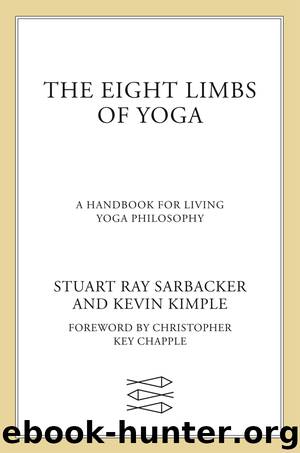The Eight Limbs of Yoga by Stuart Ray Sarbacker

Author:Stuart Ray Sarbacker
Language: eng
Format: epub
ISBN: 9780865477698
Publisher: Farrar, Straus and Giroux
Prāṇāyāma
Along with āsana, prāṇāyāma is one of the most common and recognizable practices in contemporary yoga. Many contemporary yoga traditions embrace the modern yoga form of vinyāsa, in which āsana is performed in concert with breath control. The common sun salutation, or sūrya-namaskāra, exemplifies this conception—upward and backward stretching are associated with inhalation; forward bending, with exhalation; and so forth. A key example of a prāṇāyāma utilized in āsana practice is ujjāyī prāṇāyāma, the “victorious breath control,” a haṭhayoga technique that is often integrated into vinyāsa practice, bringing intensity and control to the breath-movement link. The legacy of the medieval haṭhayoga traditions thus carries forward into the present through the continuation of a range of prāṇāyāma forms that are discussed in the Haṭhayogapradīpikā and other texts. Even in contexts where formal prāṇāyāma is not practiced as part of yoga, some aspect of breath awareness or control is typically taught as facilitating strength, stamina, and flexibility in static poses. According to K. Pattabhi Jois, one of the key figures in the development of modern yoga traditions, performing āsana without proper prāṇāyāma technique is simply physical exercise. Developing attention to, or mindfulness of, the breathing process may well be one of the hallmarks of contemporary yoga traditions, even in their most stripped-down forms. One of the lessons of modern yoga is that āsana practice requires a heightened consciousness of the breathing process. Developing strength, stamina, and flexibility in āsana practice often requires the deepening of the breath and the development of increasingly subtle control over the movements of body and breath. Both āsana and prāṇāyāma could thus be said to override the “survival wiring” of the human body, establishing volitional control over aspects of one’s embodiment that are otherwise set within certain given parameters and autonomous in operation.
As with āsana, the discussion of prāṇāyāma is given a limited number of verses in the Yogasūtra—a total of five. The first verse simply defines prāṇāyāma as the stopping of the movement of the inhalation and exhalation of breath. In other words, the basic principle of prāṇāyāma is the controlling of the movement of inhalation and exhalation. The second verse on prāṇāyāma provides a more detailed analysis of this process of control, noting that it can be broken down into “external,” “internal,” and “suppressed,” and observed in terms of place, time, and number. The drawing of breath becomes increasingly long and subtle. The key ideas here involve the notions of what are referred to as recaka, pūraka, and kumbhaka in haṭhayoga and modern yoga traditions: namely, exhalation, inhalation, and retention. One well-known example is the 1:4:2 sequence of timing with respect to inhalation, retention, and exhalation, in which the proportionate length of the count of each part follows the formula. One might perform a particular number of repetitions or number of sets of the sequence. Some commentators interpret the second verse as referring specifically to retention and its various forms, which are of particular import in many of the prāṇāyāma systems. Whether this is the
Download
This site does not store any files on its server. We only index and link to content provided by other sites. Please contact the content providers to delete copyright contents if any and email us, we'll remove relevant links or contents immediately.
| Acupuncture & Acupressure | Aromatherapy |
| Ayurveda | Chelation |
| Chinese Medicine | Energy Healing |
| Healing | Herbal Remedies |
| Holistic | Homeopathy |
| Hypnotherapy | Massage |
| Meditation | Naturopathy |
| Reference |
Inner Engineering: A Yogi's Guide to Joy by Sadhguru(6725)
The Power of Now: A Guide to Spiritual Enlightenment by Eckhart Tolle(5605)
Fear by Osho(4662)
Ikigai by Héctor García & Francesc Miralles(4125)
The Art of Happiness by The Dalai Lama(4063)
The Ultimate Bodybuilding Cookbook by Kendall Lou Schmidt(3886)
Yoga Therapy by Mark Stephens(3703)
The Little Book of Hygge by Meik Wiking(3647)
The Healing Self by Deepak Chopra(3474)
Why Buddhism is True by Robert Wright(3404)
Being Aware of Being Aware by Rupert Spira(3229)
The Hatha Yoga Pradipika (Translated) by Svatmarama(3229)
Shift into Freedom by Loch Kelly(3134)
Wild Words from Wild Women by Stephens Autumn(3092)
Work Clean by Dan Charnas(3048)
Happiness by Matthieu Ricard(2992)
More Language of Letting Go: 366 New Daily Meditations by Melody Beattie(2967)
Yoga Body & Mind Handbook by Jasmine Tarkeshi(2835)
Why I Am Not a Feminist by Jessa Crispin(2695)
